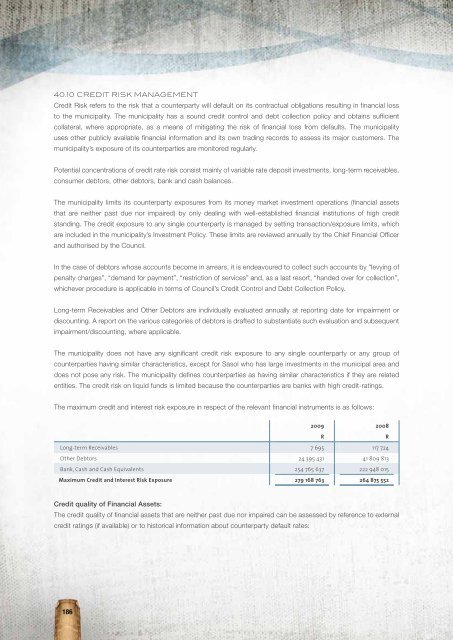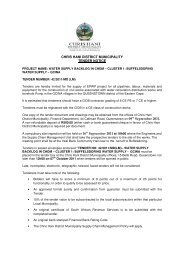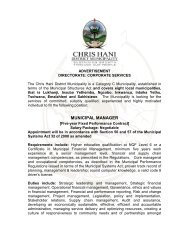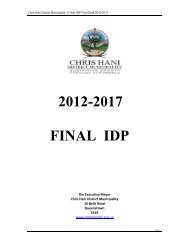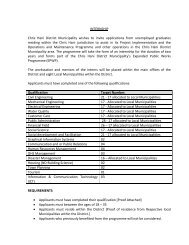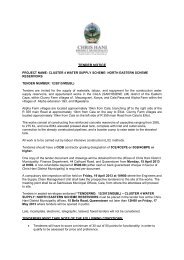Entire Document - Chris Hani District Municipality
Entire Document - Chris Hani District Municipality
Entire Document - Chris Hani District Municipality
You also want an ePaper? Increase the reach of your titles
YUMPU automatically turns print PDFs into web optimized ePapers that Google loves.
40.10 Credit Risk Management<br />
Credit Risk refers to the risk that a counterparty will default on its contractual obligations resulting in financial loss<br />
to the municipality. The municipality has a sound credit control and debt collection policy and obtains sufficient<br />
collateral, where appropriate, as a means of mitigating the risk of financial loss from defaults. The municipality<br />
uses other publicly available financial information and its own trading records to assess its major customers. The<br />
municipality’s exposure of its counterparties are monitored regularly.<br />
Potential concentrations of credit rate risk consist mainly of variable rate deposit investments, long-term receivables,<br />
consumer debtors, other debtors, bank and cash balances.<br />
The municipality limits its counterparty exposures from its money market investment operations (financial assets<br />
that are neither past due nor impaired) by only dealing with well-established financial institutions of high credit<br />
standing. The credit exposure to any single counterparty is managed by setting transaction/exposure limits, which<br />
are included in the municipality’s Investment Policy. These limits are reviewed annually by the Chief Financial Officer<br />
and authorised by the Council.<br />
In the case of debtors whose accounts become in arrears, it is endeavoured to collect such accounts by “levying of<br />
penalty charges”, “demand for payment”, “restriction of services” and, as a last resort, “handed over for collection”,<br />
whichever procedure is applicable in terms of Council’s Credit Control and Debt Collection Policy.<br />
Long-term Receivables and Other Debtors are individually evaluated annually at reporting date for impairment or<br />
discounting. A report on the various categories of debtors is drafted to substantiate such evaluation and subsequent<br />
impairment/discounting, where applicable.<br />
The municipality does not have any significant credit risk exposure to any single counterparty or any group of<br />
counterparties having similar characteristics, except for Sasol who has large investments in the municipal area and<br />
does not pose any risk. The municipality defines counterparties as having similar characteristics if they are related<br />
entities. The credit risk on liquid funds is limited because the counterparties are banks with high credit-ratings.<br />
The maximum credit and interest risk exposure in respect of the relevant financial instruments is as follows:<br />
2009 2008<br />
R<br />
R<br />
Long-term Receivables 7 695 117 724<br />
Other Debtors 24 395 431 41 809 813<br />
Bank, Cash and Cash Equivalents 254 765 637 222 948 015<br />
Maximum Credit and Interest Risk Exposure 279 168 763 264 875 552<br />
Credit quality of Financial Assets:<br />
The credit quality of financial assets that are neither past due nor impaired can be assessed by reference to external<br />
credit ratings (if available) or to historical information about counterparty default rates:<br />
186


